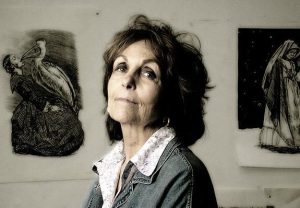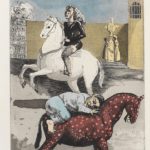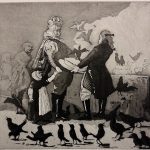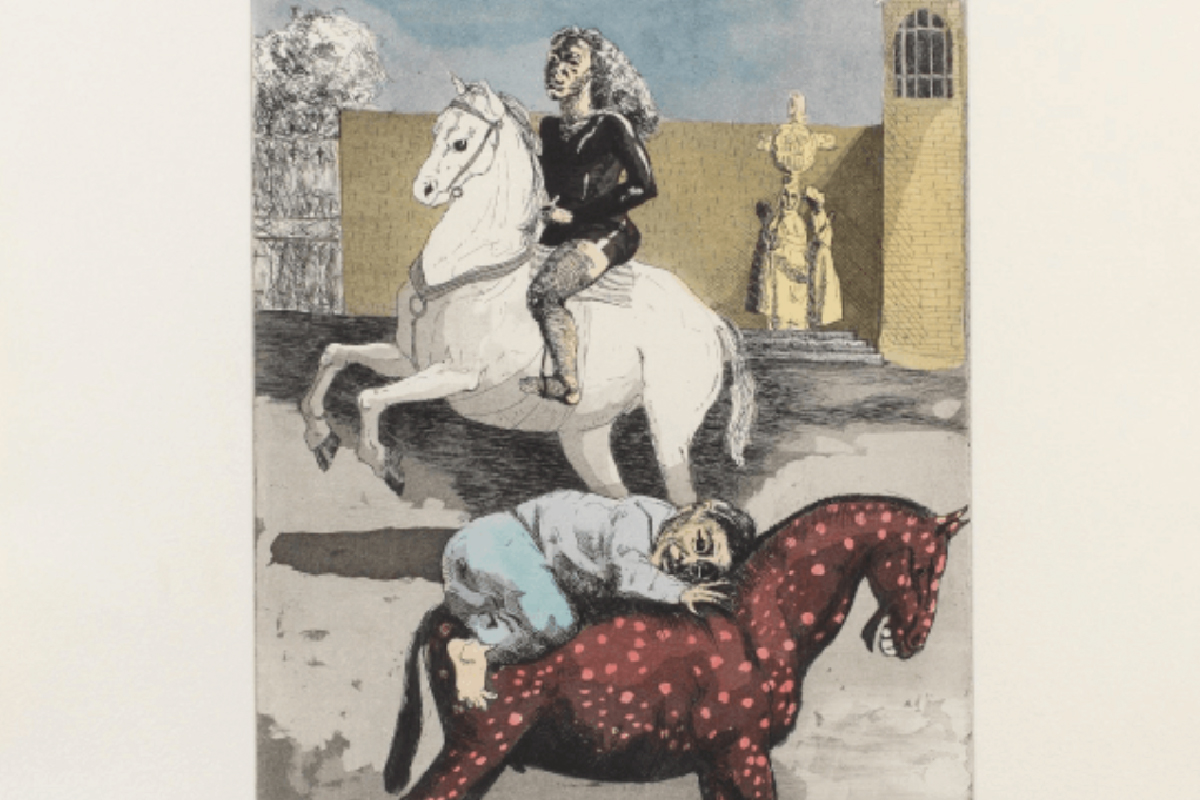Paula Rego Artwork: Paula Rego, born in Lisbon, Portugal, was one of the most important and influential Portuguese artists of the 20th and 21st centuries. Her works, characterized by a figurative, expressionist, and narrative style, address themes such as power, violence, sex, family, politics, religion, and female identity through a rich and original visual language. She lived in England since the age of 17 but maintained a strong connection to her homeland, Portugal, where she has a museum dedicated to her work, the Casa das Histórias Paula Rego.
This article aims to delve into the depths of Paula Rego’s artistic world, exploring her distinctive style, recurring themes, and the impact of her creations.
1. Biographical Context

Photo by CamoesBerlim
Paula Rego was born in Lisbon in 1935 into a family of the upper bourgeoisie, with a liberal and republican tradition. Her father, José Figueiroa Rego, was an electrical engineer who encouraged her artistic vocation and sent her to study in London in 1952 to escape the Salazar regime. Her mother, Maria de São José Avanti Quaresma de Paiva Figueiroa Rego, was a cultured and elegant woman who instilled in her a love for literature and fashion.
In London, Paula Rego attended the Slade School of Fine Art, where she graduated in painting in 1956 and met her future husband, the painter Victor Willing, born in Egypt in 1928. Paula Rego and Victor Willing divided their lives between Portugal and England, but it was in the latter country that they developed the majority of their artistic activity.
Artistic Evolution
Beginning with works influenced by surrealism and folk art, Paula Rego employed techniques such as pastel and collage. Evolving into a more realistic and expressionistic style, she utilized oil, acrylic, printmaking, and drawing. Drawing inspiration from her own life, literature, history, popular culture, and mythology, her works craft visual narratives that explore power dynamics, violence, sex, family, politics, religion, and female identity. Often, these narratives incorporate anthropomorphic animals, grotesque figures, erotic symbols, and ironic references. Works like “The Family” (1988), “The Abortion” (1998-1999), “The Dance” (1988-1989), “The Crime of Father Amaro” (2004), “The Dog Woman” (1994), and “The Scream of Imagination” (2010) have brought her recognition. Additionally, she has a cultural centre dedicated to her work in Cascais, the Paula Rego House of Stories, which opened in 2009 and was designed by architect Eduardo Souto de Moura.
Furthermore, Paula Rego was a bold, innovative, and imaginative artist who adeptly conveyed her worldview through her art. She was also a staunch advocate for women’s rights and freedom. Her contributions were recognized with various awards and distinctions, including the Grand Cross of the Military Order of Saint James of the Sword (2004), the Dame Commander of the Order of the British Empire (2010), an honorary doctorate from the University of Lisbon (2011), and her appointment as a Royal Academician (2016). She passed away in London in 2022 at the age of 87, leaving behind an artistic and cultural legacy of immense value to Portugal and the world.
2. Paula Rego’s Artwork Style
Paula Rego’s artwork is characterized by figurative, expressionistic, and narrative language that explores themes such as power, violence, sex, family, politics, religion, and female identity through a rich and original visual language. Also, she employs various techniques and materials, including oil, acrylic, pastel, collage, printmaking, and drawing, creating works that blend reality and fantasy, humour and drama, irony, and critique.
Surrealist Influences: A Journey into Dreamlike Grotesque
In the 1960s, Paula Rego embraced surrealism, drawing inspiration from Joan Miró and adopting the technique of automatism. She employed this method to craft dreamlike and grotesque scenes featuring human figures, animals, and objects that evoked memories of her childhood, family, and culture. Paula Rego not only assimilated surrealistic influences but also infused her work with unique surreal elements, thereby forging her distinctive and original artistic universe.
Another distinctive characteristic of Paula Rego’s style is her narrative ability to tell stories through images. Paula Rego had a deep interest in literature, history, popular culture, and mythology, and she used these sources as inspiration for her works. She crafted visual narratives representing situations, characters, conflicts, and outcomes that can be interpreted in various ways by the viewer. She also used narrative to express her opinions on social, political, and moral issues, such as abortion, domestic violence, censorship, religion, and the role of women in society.
Colour as Expression: The Palette of Emotion and Symbolism
A third element that characterizes Paula Rego’s style is her use of colour, which is employed expressively, symbolically, and in contrast. Paula Rego uses colour to create atmospheres, convey emotions, highlight elements, and suggest meanings. She employs strong, vibrant, and saturated colours that contrast with dark, sombre, and opaque ones, creating a dramatic and impactful effect. She also uses colours that reference her culture, such as blue and white, evoking the sea, the sky, and Portuguese tiles, or red and yellow, suggesting blood, fire, and the sun.
3. Notable Works
Paula Rego created works throughout her artistic career that stand out for their originality, expressiveness, and meaning. Some of her most important and emblematic works are:
• “The Family” (1988)
This work stands out as one of Paula Rego’s most well-known and impactful pieces. In it, she portrays a family scene that exposes a situation of violence, abuse, and oppression. The central figure, dressed as a man and wielding a cane symbolizing authority and power, dominates and humiliates her injured, naked husband lying on the ground. Adjacent to them, their two children witness the scene with indifference and fear. This powerful artwork serves as a critique of family dynamics and power, highlighting their potential for oppression and destruction.
• “The Abortion” (1998-1999)
Comprising a series of 14 pastel paintings, this collection portrays diverse women undergoing illegal and hazardous abortion procedures. It serves as a condemnation of the plight faced by women in Portugal, where abortion was not only illegal but also criminalized, subjecting many women to physical and psychological repercussions. Additionally, the work carries a personal dimension, as Paula Rego disclosed her own experience of undergoing an abortion in London during her youth. The impact of this collection on public opinion and politics was substantial, playing a role in the legalization of abortion in Portugal in 2007.
• “The Dance” (1988-1989)
This work is one of Paula Rego’s most joyful and colourful. In it, she portrays a group of women dressed extravagantly and sensually, dancing and having fun in a ballroom. The work celebrates life, freedom, and femininity, in contrast to her previous, darker and more dramatic works. The work also references Portuguese popular culture, as the women wear masks and typical Carnival accessories such as the bowler hat, fan, umbrella, and balloon.
• “The Crime of Father Amaro” (2004)
This work is one of Paula Rego’s most controversial and provocative. It is inspired by Eça de Queirós’ novel of the same name, which tells the story of a priest who becomes involved with a young woman who becomes pregnant and dies. Also, the work is a critique of the hypocrisy and corruption of the Catholic Church, which condemns sex and abortion while covering up its own sins and crimes. It also challenges the moral and religious values of Portuguese society, which was still very conservative and influenced by Catholicism. The work caused scandal and outrage, leading to censorship and vandalism.
• “The Dog Woman” (2006)
This work is one of Paula Rego’s most original and creative. In it, she represents a woman who transforms into a dog or identifies with a dog and lives in a relationship of love and dependence with a man. The work is a metaphor for the female condition, which is seen as inferior, submissive, and animal-like, requiring protection and affection. The work is also a reflection on identity, sexuality, and fantasy, recurring themes in Paula Rego’s work.
Nursery Rhymes Series

• “RIDE A COCK-HORSE” (1989)
“RIDE A COCK-HORSE” is one of the 25 etchings that constitute the Nursery Rhymes series (1989) by Portuguese artist Paula Rego. The series draws inspiration from traditional English nursery rhymes, reimagined by the artist with an expressive and ironic style. The image is a visual reference to the rhyme “Ride a cock-horse to Banbury Cross, to see a fine lady upon a white horse. Rings on her fingers and bells on her toes, she shall have music wherever she goes.” The rhyme alludes to Queen Elizabeth I of England, who visited the town of Banbury in 1575. Paula Rego transforms the rhyme into a surreal and humorous scene, where the woman appears to defy social conventions. The etching was created using aquatint and watercolor, hand-colored by Charlotte Hodes.

• “SING A SONG OF SIXPENCE” (1989)
4. Impact and International Recognition
Throughout her career, Paula Rego has secured a prominent standing in the contemporary art realm, earning global acclaim. Her distinctive repertoire, blending figurative, expressionist, and narrative elements, has served as a wellspring of inspiration for artists worldwide.
Moreover, her influence transcends Portugal’s borders, reshaping the perception and appreciation of art. Displayed in galleries and museums across diverse countries, her paintings actively contribute to the global recognition and prominence of Portuguese contemporary art. The richness and originality of her visual language incite debates and discussions, fostering a heightened appreciation for art and its ability to articulate intricate and universal themes.
In addition to exhibitions in renowned art institutions, she has received honours that underscore the significance of her work. Among these distinctions are the Grand Cross of the Military Order of Saint James of the Sword, the Dame Commander of the Order of the British Empire, an honorary doctorate from the University of Lisbon, and the title of Royal Academician.
Paula Rego’s legacy is both a testament to her talent and an expression of her artistic courage and originality. Her work challenges conventions explores complex themes, and allows art to fulfil its role as an agent of social and cultural transformation. Paula Rego is not only a renowned artist but also an iconic figure who has left an indelible mark on the history of contemporary art, inspiring future generations to embrace creative expression in all its forms.
Paula Rego Artwork: Conclusion
Born in Lisbon, Paula Rego has left a lasting impact on contemporary art. With a figurative, expressionist, and narrative style, she tackled complex themes such as power, violence, sex, and female identity. Although she lived much of her life in England, she maintained a strong connection with Portugal, where her museum, the Paula Rego House of Stories, stands as a testament to her legacy.
Through iconic works, Paula Rego not only ignited debates but also challenged conventions. Her style, characterized by surreal elements, rich narratives, and expressive use of colours, significantly enriched the artistic landscape. Furthermore, her influence transcended borders, inspiring artists worldwide.
Beyond her artistic legacy, Paula Rego garnered international recognition through exhibitions and honours. Her original and provocative work serves as a testament to art’s capacity to express the complexity of the human condition. Moreover, Paula Rego stands as an iconic figure in the history of contemporary art, inspiring creative expression in all its forms.
For a deeper immersion into the profound narratives crafted by this visionary artist, we invite you to visit our gallery GL-ARTE, where you can explore firsthand the captivating world of Paula Rego’s creations.

